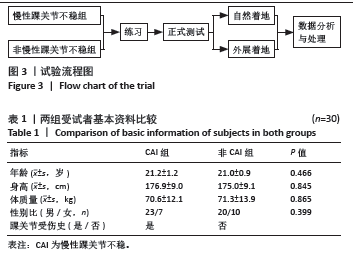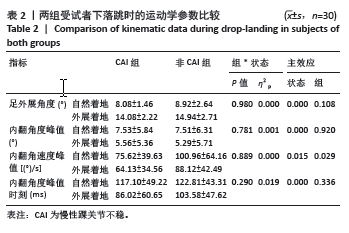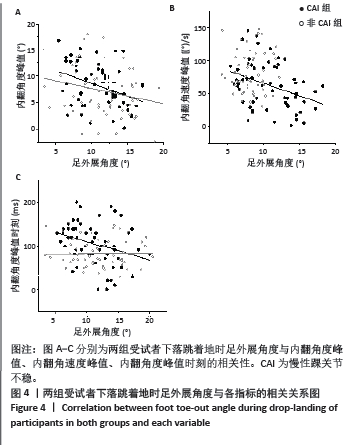[1] FONG DT, HONG Y, CHAN LK, et al. A systematic review on ankle injury and ankle sprain in sports. Sports Med. 2007;37(1):73-94.
[2] KONRADSEN L, BECH L, EHRENBJERG M, et al. Seven years follow-up after ankle inversion trauma. Scand J Med Sci Sports. 2002;12(3): 129-135.
[3] SOBOROFF SH, PAPPIUS EM, KOMAROFF AL. Benefits, risks, and costs of alternative approaches to the evaluation and treatment of severe ankle sprain. Clin Orthop Relat Res. 1984;(183):160-168.
[4] GRIBBLE PA, DELAHUNT E, BLEAKLEY C, et al. Selection criteria for patients with chronic ankle instability in controlled research: a position statement of the International Ankle Consortium. J Orthop Sports Phys Ther. 2013;43(8):585-591.
[5] DELAHUNT E, COUGHLAN GF, CAULFIELD B, et al. Inclusion criteria when investigating insufficiencies in chronic ankle instability. Med Sci Sports Exerc. 2010;42(11):2106-2121.
[6] MCKAY GD, GOLDIE PA, PAYNE WR, et al. Ankle injuries in basketball: injury rate and risk factors. Br J Sports Med. 2001;35(2):103-108.
[7] BRINER WW, JR, KACMAR L. Common injuries in volleyball. Mechanisms of injury, prevention and rehabilitation. Sports Med. 1997;24(1):65-71.
[8] FONG DT, HA SC, MOK KM, et al. Kinematics analysis of ankle inversion ligamentous sprain injuries in sports: five cases from televised tennis competitions. Am J Sports Med. 2012;40(11):2627-2632.
[9] DELAHUNT E, REMUS A. Risk Factors for Lateral Ankle Sprains and Chronic Ankle Instability. J Athl Train. 2019;54(6):611-616.
[10] SIMPSON JD, KOLDENHOVEN RM, WILSON SJ, et al. Lower extremity joint kinematics of a simulated lateral ankle sprain after drop landings in participants with chronic ankle instability. Sports Biomech. 2022; 21(4):428-446.
[11] TERRIER R, ROSE-DULCINA K, TOSCHI B, et al. Impaired control of weight bearing ankle inversion in subjects with chronic ankle instability. Clin Biomech (Bristol, Avon). 2014;29(4):439-343.
[12] TERADA M, GRIBBLE PA. Jump Landing Biomechanics During a Laboratory Recorded Recurrent Ankle Sprain. Foot Ankle Int. 2015; 36(7):842-848.
[13] KOSHINO Y, ISHIDA T, YAMANAKA M, et al. Toe-in Landing Increases the Ankle Inversion Angle and Moment During Single-Leg Landing: Implications in the Prevention of Lateral Ankle Sprains. J Sport Rehabil. 2017;26(6):530-535.
[14] FUERST P, GOLLHOFER A, WENNING M, et al. People with chronic ankle instability benefit from brace application in highly dynamic change of direction movements. J Foot Ankle Res. 2021;14(1):13.
[15] BEUMER A, VAN HEMERT WL, SWIERSTRA BA, et al. A biomechanical evaluation of the tibiofibular and tibiotalar ligaments of the ankle. Foot Ankle Int. 2003;24(5):426-429.
[16] KHAN SS, KHAN SJ, USMAN J. Effects of toe-out and toe-in gait with varying walking speeds on knee joint mechanics and lower limb energetics. Gait Posture. 2017;53:185-192.
[17] GEHRING D, FASCHIAN K, LAUBER B, et al. Mechanical instability destabilises the ankle joint directly in the ankle-sprain mechanism. Br J Sports Med. 2014;48(5):377-382.
[18] MOKHTARZADEH H, YEOW CH, GOH JCH, et al. Antagonist muscle co-contraction during a double-leg landing maneuver at two heights. Comput Methods Biomech Biomed Engin. 2017;20(13):1382-1393.
[19] ANDERSEN TE, FLOERENES TW, ARNASON A, et al. Video analysis of the mechanisms for ankle injuries in football. Am J Sports Med. 2004; 32(1 Suppl):69s-79s.
[20] HA SC, FONG DT, CHAN KM. Review of ankle inversion sprain simulators in the biomechanics laboratory. Asia Pac J Sports Med Arthrosc Rehabil Technol. 2015;2(4):114-121.
[21] FONG DT, CHAN YY, MOK KM, et al. Understanding acute ankle ligamentous sprain injury in sports. Sports Med Arthrosc Rehabil Ther Technol. 2009;1:14.
[22] BHASKARAN D, WORTLEY M, CHEN Q, et al. Effect of a combined inversion and plantarflexion surface on ankle kinematics and EMG activities in landing. J Sport Health Sci. 2015;4(4):377-383.
[23] BECHARD DJ, BIRMINGHAM TB, ZECEVIC AA, et al. Toe-out, lateral trunk lean, and pelvic obliquity during prolonged walking in patients with medial compartment knee osteoarthritis and healthy controls. Arthritis Care Res (Hoboken). 2012;64(4):525-532.
[24] GU L, QIU H, ZHANG S, et al. [Analysis of the relevance of age and toe out angle of normal adults’ gait]. Sheng Wu Yi Xue Gong Cheng Xue Za Zhi. 2018;35(1):45-48.
[25] MCILROY WE, MAKI BE. Preferred placement of the feet during quiet stance: development of a standardized foot placement for balance testing. Clin Biomech (Bristol, Avon). 1997;12(1):66-70.
[26] BENNOUR S, ULRICH B, LEGRAND T, et al. Effects of foot progression angle on knee biomechanics during gait modification. Comput Methods Biomech Biomed Engin. 2017;20(sup1):17-18.
[27] SINCLAIR J, TAYLOR PJ, HOBBS SJ. Digital filtering of three-dimensional lower extremity kinematics: an assessment. J Hum Kinet. 2013;39: 25-36.
[28] COHEN J. Statistical Power Analysis for the Behavioural Sciences. Hillsdale, NJ: Earlbaum Associates. 1988.
[29] KIM H, SON SJ, SEELEY MK, et al. Altered movement strategies during jump landing/cutting in patients with chronic ankle instability. Scand J Med Sci Sports. 2019;29(8):1130-1140.
[30] GUTIERREZ GM, KAMINSKI TW, DOUEX AT. Neuromuscular control and ankle instability. PM R. 2009;1(4):359-365.
[31] DULLAERT K, HAGEN J, KLOS K, et al. The influence of the Peroneus Longus muscle on the foot under axial loading: A CT evaluated dynamic cadaveric model study. Clin Biomech (Bristol, Avon). 2016;34:7-11.
[32] KONRADSEN L. Sensori-motor control of the uninjured and injured human ankle. J Electromyogr Kinesiol. 2002;12(3):199-203.
[33] CZAJKA CM, TRAN E, CAI A N, et al. Ankle sprains and instability. Med Clin North Am. 2014;98(2):313-329.
[34] MEDINA MCKEON JM, HOCH MC. The Ankle-Joint Complex: A Kinesiologic Approach to Lateral Ankle Sprains. J Athl Train. 2019;54(6): 589-602.
[35] LEE PJ, ROGERS EL, GRANATA KP. Active trunk stiffness increases with co-contraction. J Electromyogr Kinesiol. 2006;16(1):51-57.
[36] GUTIERREZ GM, KNIGHT CA, SWANIK CB, et al. Examining neuromuscular control during landings on a supinating platform in persons with and without ankle instability. Am J Sports Med. 2012; 40(1):193-201.
[37] LI Y, KO J, WALKER MA, et al. Does chronic ankle instability influence lower extremity muscle activation of females during landing? J Electromyogr Kinesiol. 2018;38:81-87.
[38] BONASERA SJ, NICHOLS TR. Mechanical actions of heterogenic reflexes among ankle stabilizers and their interactions with plantarflexors of the cat hindlimb. J Neurophysiol. 1996;75(5):2050-2070.
[39] HAMOUDA A, KENNEY L, HOWARD D. Dealing with time-varying recruitment and length in Hill-type muscle models. J Biomech. 2016; 49(14):3375-3380.
[40] HAEUFLE DF, GÜNTHER M, BAYER A, et al. Hill-type muscle model with serial damping and eccentric force-velocity relation. J Biomech. 2014;47(6):1531-1536.
[41] SIMPSON JD, STEWART EM, TURNER AJ, et al. Neuromuscular control in individuals with chronic ankle instability: A comparison of unexpected and expected ankle inversion perturbations during a single leg drop-landing. Hum Mov Sci. 2019;64:133-141.
[42] SIMPSON JD, STEWART EM, RENDOS NK, et al. Anticipating ankle inversion perturbations during a single-leg drop landing alters ankle joint and impact kinetics. Hum Mov Sci. 2019;66:22-30.
[43] HERTEL J. Sensorimotor deficits with ankle sprains and chronic ankle instability. Clin Sports Med. 2008;27(3):353-370, vii.
|


